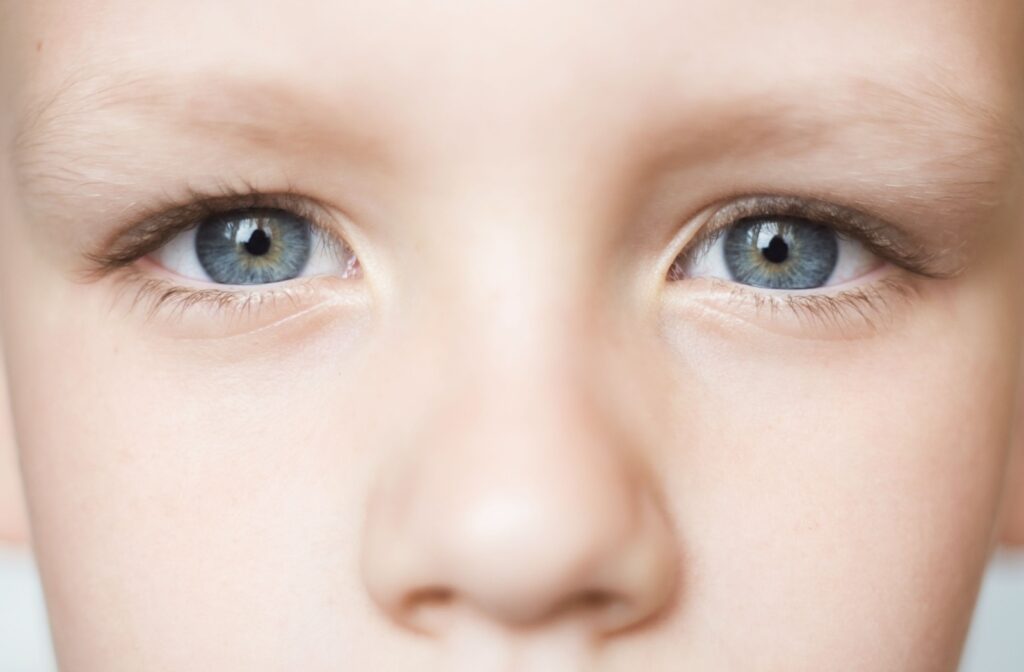As a parent, you pay close attention to your child’s growth, from measuring their height on a doorframe to buying new shoes every few months. But did you know their eyes are growing too? This growth plays a significant part in their vision, especially when it comes to myopia. Proactively managing your child’s eyesight is a key part of their overall health and academic success.
You might wonder how the physical growth of the eye is connected to your child’s prescription. Axial length, the length of the eye from front to back, plays a direct role in myopia progression because an eye that grows too long causes light to focus incorrectly in the eye, thereby causing blurry distance vision.
Myopia control is the first step toward managing your child’s vision proactively.
What Is Myopia & Axial Length?
A Simple Look at Nearsightedness
Myopia is the clinical term for nearsightedness, a common vision condition where you can see objects up close clearly, but objects farther away appear blurry. This often happens when the eye grows slightly too long from front to back. It frequently develops during childhood and can progress as a child grows.
How the Shape of Your Eye Affects Vision
Think of your eye as a camera. The cornea and lens at the front of your eye work together to focus light directly onto the retina at the back—much like a camera lens focuses light onto a sensor. For you to see clearly, this focal point must land precisely on the retina.
Axial Length Explained in Plain Terms
Axial length is simply the measurement of how long the eye is, from the clear front surface (the cornea) to the light-sensitive tissue in the back (the retina). A small change in this length can have a noticeable impact on a person’s vision.
How a Longer Eye Can Cause Blurry Vision
The Connection Between Eye Growth & Myopia
When a child’s eye grows too quickly or becomes too long, the distance between the lens and the retina increases. This causes light to focus at a point in front of the retina instead of directly on it. This mismatch is what creates the blurry distance vision associated with myopia.
Why Myopia Tends to Progress in Children
A child’s body, including their eyes, grows rapidly. This period of development is when myopia often appears and can worsen year after year. The eye’s axial length can continue to increase throughout the school years, leading to a stronger prescription over time and making early intervention with myopia control strategies particularly important.
Signs of Myopia Progression to Watch For
Children may not always tell you their vision is changing. It’s helpful to watch for subtle clues that they might be struggling to see clearly at a distance. These signs can include:
- Frequent squinting to see distant objects
- Needing to sit closer to screens or boards
- Headaches from digital eye strain
- Complaints of blurry distance vision
The Importance of Myopia Management
More Than Just Stronger Glasses
While new glasses or contact lenses can help your child see clearly, they only correct the symptom: the blurriness. Myopia management aims to address the cause by using specific treatments to help slow the elongation of the eye. This approach goes beyond just correcting vision.
Focus on Long-Term Eye Health
The goal of myopia management is to slow its progression during the critical growing years. Keeping a child’s prescription lower can contribute positively to their long-term eye health and reduce the risks associated with high myopia later in life. It’s about looking at the big picture of your child’s vision for years to come.
A Proactive Approach to Vision Care
Instead of just reacting to vision changes with stronger prescriptions, myopia management offers a proactive path. By monitoring axial length and implementing a personalized plan, we can actively work to manage the changes in your child’s eyes. This helps support both their current vision as well as their future well-being.
Explore Myopia Control Options
Specialty Contact Lenses
Certain types of contact lenses can correct myopia and slow its progression. These are designed with different zones that help focus light in a way that can signal the eye to slow its axial growth.
Prescription Eye Drops
Low-dose atropine eye drops are another option for myopia management. These drops are used once a day and work by relaxing the eye’s focusing mechanism. Regular use of these drops helps slow the progression of myopia.
Eyeglasses Designed for Myopia Control
Myopia control can also be achieved with spectacle lenses. Much like myopia control contact lenses, these lenses are designed to affect how light focuses on peripheral regions of the eye, which can help slow down the progression of myopia.

How Eye Doctors Measure Axial Length
A Quick & Simple Process
Measuring axial length is a straightforward and comfortable part of a comprehensive eye exam. We use a non-invasive instrument that takes a precise measurement in just a few seconds without ever touching the eye. The process is quick and easy, even for young children.
What This Measurement Tells Us
This single number gives us objective data about the physical size of your child’s eye. This allows us to better assess the current level of myopia and monitor its progression.
Track Changes in Eye Growth Over Time
One of the most powerful uses of axial length measurement is tracking it over time. By comparing measurements from one visit to the next, we can see exactly how fast the eye is growing. This information helps us determine if a myopia management plan is effective or if adjustments are needed.
Talk with Eye Doctors in Kitchener-Waterloo
A Clear Picture of Your Child’s Eye Health
A comprehensive children’s eye exam that includes axial length measurement provides a complete overview of your child’s vision. It allows us to move beyond the prescription and understand the underlying factors of their myopia. This gives us the information we need to protect their sight.
Develop a Custom Myopia Plan
Every child’s eyes are unique, and so is their myopia management plan. After a thorough assessment, we can discuss the options that fit your child’s lifestyle and visual needs. Our team is here to answer your questions and help you make an informed decision.
Schedule a Children’s Eye Exam
If you have concerns about your child’s vision, our team at Waterloo Vision Care Clinic is ready to help. As dedicated eye doctors in Kitchener-Waterloo, we use modern technology to support your family’s eye health. Contact us today to schedule an appointment and learn more about myopia management.




